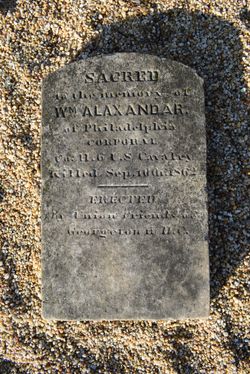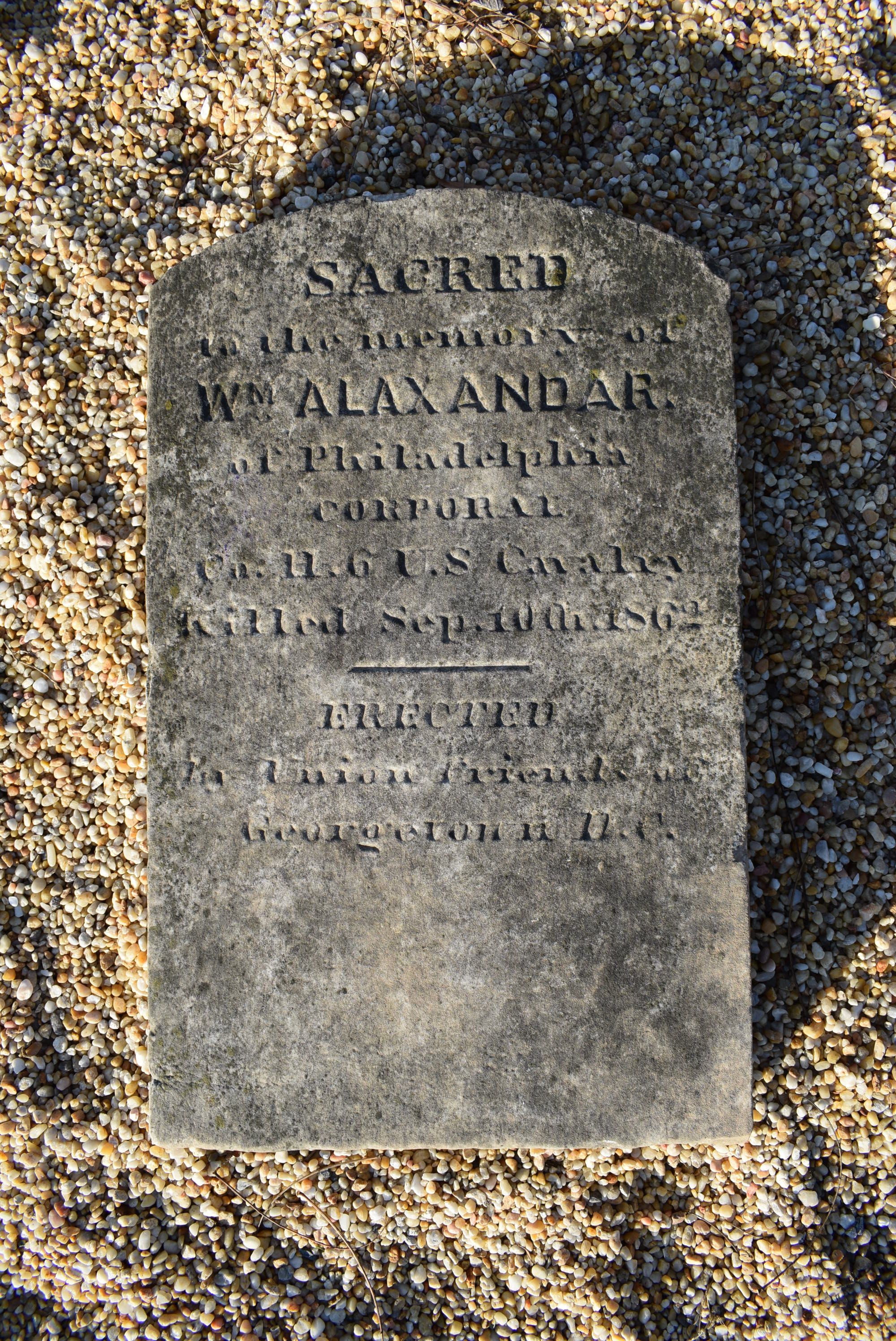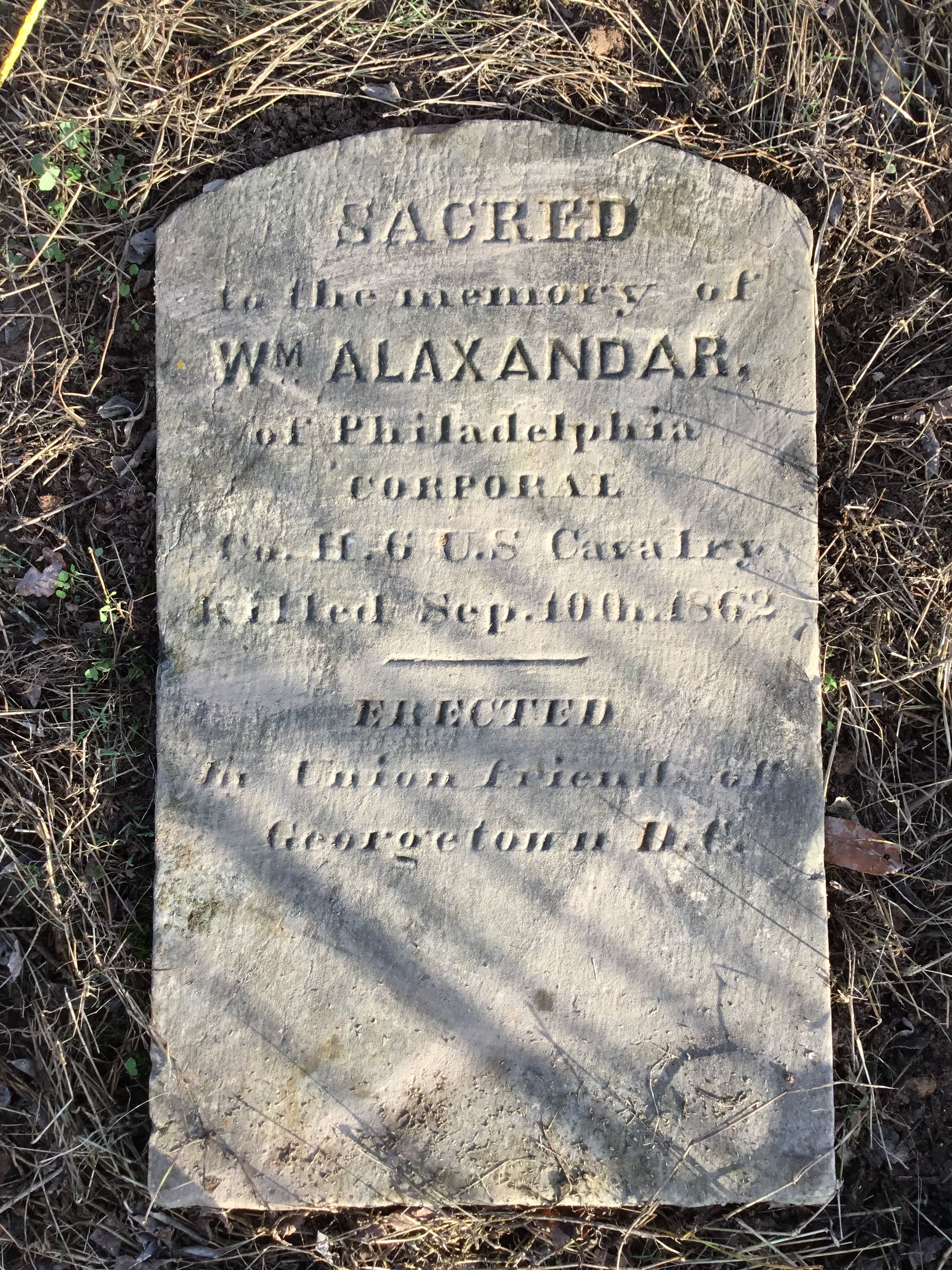William Alexander was a member of the 6th United States Cavalry (Regular Army), Company H. A native of County Down, Ireland, he enlisted as a Private on August 17, 1861 at Philadelphia, at the age of 18, and listed his occupation as a plasterer. At some point he was promoted to Corporal, but records do not survive. He was wounded in action September 10, 1862, and died the same day. There is no record of any relative seeking a pension after his death, which is understandable, given the fact that his remains were not moved from the church cemetery in Barnesville. Many Regular Army recruits were recent immigrants.
The regiment's presence in Maryland can be considered as an early portion of the Antietam Campaign. After fighting in Virginia earlier in the war, the regiment was sent to Alexandria by ship, arriving on September 2, 1862. They marched through Falls Church and Tenallytown to Darnestown, where they arrived on September 8. With the 1st Massachusetts Cavalry, they led the Federal VI Corps the next day to Barnesville, where they bivouacked for the night. One member wrote: ". . . the men kindled their fires, made themselves some strong coffee, toasted some pickled pork on a stick, fried their crackers in grease and sugar, unfastened, fed, and groomed their horses, and spread out their blankets and laid down."
Federal cavalry consisting of the 6th U.S., 8th Pennsylvania, 8th Illinois, and 3rd Indiana, along with a section of Battery M, 2nd U.S. Artillery, were combined and ordered to take Sugar Loaf Mountain on September 10. Unbeknownst to the Federals, the mountain was defended by about 500 men from two infantry regiments and a 4-gun artillery battery. The 6th U.S. Cavalry served as the left flank squadron.. They made two uphill advances, and were driven back by heavy infantry and artillery fire both times. Before withdrawing to Barnesville, the 6th U.S. Cavalry sustained two casualties--Corporal William Alexander was killed and Private Marshall Gibby of Company B was wounded in the right arm. Federal VI Corps infantry took Sugar Loaf Mountain the following day.
American Civil War Database
Donald C. Caughey and Jimmy L. Jones, The 6th United States Cavalry in the Civil War: A History and Roster (Jefferson, NC: McFarland & Co., 2013).
National Archives Civil War Pension Index
Died from wounds received in battle during the Civil War skirmish of Barnesville on Sept. 9, 1862.
William Alexander was a member of the 6th United States Cavalry (Regular Army), Company H. A native of County Down, Ireland, he enlisted as a Private on August 17, 1861 at Philadelphia, at the age of 18, and listed his occupation as a plasterer. At some point he was promoted to Corporal, but records do not survive. He was wounded in action September 10, 1862, and died the same day. There is no record of any relative seeking a pension after his death, which is understandable, given the fact that his remains were not moved from the church cemetery in Barnesville. Many Regular Army recruits were recent immigrants.
The regiment's presence in Maryland can be considered as an early portion of the Antietam Campaign. After fighting in Virginia earlier in the war, the regiment was sent to Alexandria by ship, arriving on September 2, 1862. They marched through Falls Church and Tenallytown to Darnestown, where they arrived on September 8. With the 1st Massachusetts Cavalry, they led the Federal VI Corps the next day to Barnesville, where they bivouacked for the night. One member wrote: ". . . the men kindled their fires, made themselves some strong coffee, toasted some pickled pork on a stick, fried their crackers in grease and sugar, unfastened, fed, and groomed their horses, and spread out their blankets and laid down."
Federal cavalry consisting of the 6th U.S., 8th Pennsylvania, 8th Illinois, and 3rd Indiana, along with a section of Battery M, 2nd U.S. Artillery, were combined and ordered to take Sugar Loaf Mountain on September 10. Unbeknownst to the Federals, the mountain was defended by about 500 men from two infantry regiments and a 4-gun artillery battery. The 6th U.S. Cavalry served as the left flank squadron.. They made two uphill advances, and were driven back by heavy infantry and artillery fire both times. Before withdrawing to Barnesville, the 6th U.S. Cavalry sustained two casualties--Corporal William Alexander was killed and Private Marshall Gibby of Company B was wounded in the right arm. Federal VI Corps infantry took Sugar Loaf Mountain the following day.
American Civil War Database
Donald C. Caughey and Jimmy L. Jones, The 6th United States Cavalry in the Civil War: A History and Roster (Jefferson, NC: McFarland & Co., 2013).
National Archives Civil War Pension Index
Died from wounds received in battle during the Civil War skirmish of Barnesville on Sept. 9, 1862.
Inscription
NOTE: His surname is misspelled.
Advertisement
Advertisement



